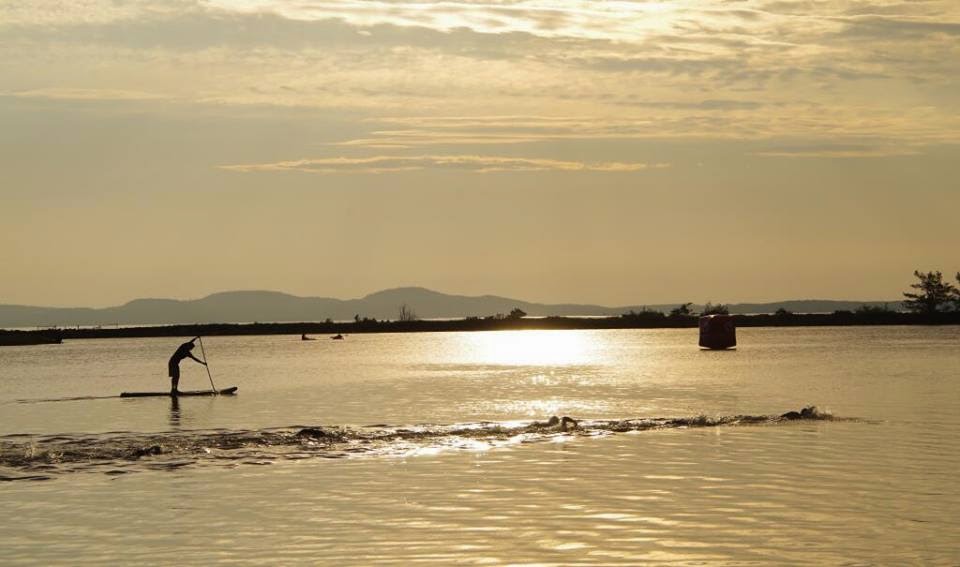Before describing my race at Challenge St. Andrews, I would like to highlight a far more impressive performance that took place at this event. This performance occurred both on and off the race course; in the months, weeks and days prior to the race; and it involved a passionate team of people with an entire community rallying behind them. I’m referring of course to the masterful display of event management and the tireless work of the volunteers that pulled off this world class event mere hours after Hurricane Arthur rolled through. Twelve hours before the start, the power was still out, the course was in shambles, and athletes were preparing for disappointment. Yet somehow we awoke to a clear course, perfect weather and an electric race atmosphere.
My own performance was also not without mishaps. Even so, I walked away with my best result and biggest payday of my young pro career, as well as a good lesson. Full result are here and read on for a race report punctuated as usual by some funny animal Vines.
 |
| Out-sprinting some children. I’ve since been informed that forgetting to zip up your jersey is a faux pas in pro racing. Oh well, at least I didn’t have saggy sponge boobs à la Macca. |
Swim – 1.9 km
My confidence and consistency in the water is at an all-time high thanks to the direction of Magnolia Masters. One insight gained from Swim Coach Tim is that swimming does not require a significant taper leading into a triathlon, quite unlike running and cycling. In fact, the weeks prior to Syracuse 70.3 and Challenge St. Andrews have featured my highest quality swimming ever, followed by no coincidence by my two best half distance swims (24:40 and 24:50).

The swim took place in a small, sheltered, saltwater cove. Miraculously, the water temperature dropped from 27°C to 18°C over the 48 hours before the race which, to my great relief, allowed me to use my Nineteen Rogue. In the future, I will come prepared for a non-wetsuit swim.
With a small pro field, the swim start wasn’t as chaotic as usual, although my sprinting remains a work in progress:
All I saw of race favourite Tim O’Donnell was a receding trail of bubbles, but I soon found the feet of Canadian Jordan Bryden. We worked together throughout the swim, opening a sizable gap on the other pros but giving up a disappointing 2 minutes to TO. I flew up the long, steep hill into transition.
Bike – ~91 km
My cycling has never been stronger and I was eager to smash this ride. The rolling course suited me and I had someone to chase. I felt excellent, effortlessly finding the top of my target power range. At the first turnaround at 18 km, I was surprised to see that I hadn’t made up any ground on my competitors. Again at the second turnaround at 32 km, I appeared to be losing ground despite riding very well.
I don’t usually pay attention to my speed during races, focusing instead on power. But after averaging 311W for the first hour, I flipped my computer over to a secondary screen and was dismayed to see an average speed of less than 38 km/h. My Best Bike Split power plan, which is generally pretty accurate, had predicted ~42 km/h. With a sinking feeling I realized that I had overlooked a badly rubbing front brake!
While packing or unpacking my bike, I managed to lose the knurled washer that holds my brake centered. After an unsuccessful hunt for a replacement the day before the race, I thought that a standard washer would do the trick… wrong! Mistake #2 was forgoing my usual test ride the day before due to the hurricane.
Most equipment failures, even flat tires, are not “bad luck”. Races can be decided by being more meticulous with equipment selection and maintenance than your competitors, a fact that I exploit at every opportunity. Thankfully, in this case, I’m confident that my first ever mechanical issue didn’t affect the outcome of the race.
I resisted the urge to throw a temper tantrum (and my bike), vented my frustration with some choice words, and got my head back in the race. I managed to readjust my brake on the fly (don’t try this at home kids) and I rode the second lap a few km/h faster on less power.
I finished the ride with personal best power (302W AP at ~70 kg) and personal worst average speed for the season. Here’s my power file on Strava.
Run – 21.1 km
As expected, the time gap to Tim O’Donnell heading out on the run was depressing: ~6.5 minutes. But a lot can happen over a half marathon, so I pushed until the first turnaround at ~5 km where I could I size up the competition. TO looked strong and the pros behind me were not threatening my position. I weighed my options:
- Bury myself to run a little faster, risk further damage to a tender Achilles tendon and still finish 2nd.
- Do precisely what is required to hold 2nd place, no more, no less.
I’m not proud to admit that I chose the latter, but such is the calculus of racing as a pro. I clocked my slowest (1:19:20) and least painful half distance run ever and crossed the line well behind TO. But finishing top Canadian and earning $1000/hour* doing something I love had me skipping across the finish line:
*Does not include training, eating, sleeping, travel, social media, Slowtwitch, daydreaming, etc.
Add this race to your calendar!
I was beyond impressed with every aspect of Challenge St. Andrews, from the excellent police, volunteer and spectator presence, to the stunning course, the approachable organizers, the welcoming locals, the delicious banquets at the Algonquin Resort, and a chance chat with Olympians and World Champions including inspiration Simon Whitfield. I can’t wait to return!
A special thank you to Keystone Communications and my awesome homestay, the Tanner family. Thank you also to my sponsors and supporters, and my coaches David Tilbury-Davis and Tim Floyd. I’m now entering the second phase of my rookie pro season, starting with a mid-season break followed by some Ontario races in the MultiSport Canada Triathlon Series in July-August building into Muskoka 70.3 and Niagara Falls Barrelman.








